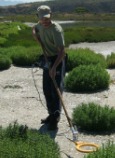 Avian Predation on Juvenile Salmonids
Avian Predation on Juvenile Salmonids
We evaluated the impact of avian predation on juvenile Steelhead Trout Oncorhynchus mykiss and yearling and subyearling Chinook Salmon O. tshawytscha by piscivorous waterbirds from 11 different breeding colonies in the Columbia River Basin, USA, during 2012 and 2014. Fish were tagged with both acoustic and passive integrated transponder (PIT) tags and tracked via a network of hydrophone arrays to estimate total smolt morality (1-survival) at various spatial and temporal scales during out-migration. Recoveries of PIT tags on bird colonies, couple with last known detections of live fish passing hydrophone arrays, were used to estimate the impact of avian predation relative to total smolt mortality. Results indicated that avian predation was a substantial source of steelhead mortality, with predation probabilities (proportion of available fish consumed by birds) ranging from 0.06–0.28 for fish traveling through the lower Snake, lower Columbia, and middle Columbia rivers. For yearling and subyearling Chinook Salmon, estimates ranged from 0.03–0.09 and 0.01–0.05 of the available tagged fish, respectively. Predation on smolts by gulls Larus spp. was concentrated near hydroelectric dams, while predation by Caspian terns Hydroprogne caspia was concentrated within the reservoirs. No concentrated areas of predation were identified for double-crested cormorants Phalacrocorax auritus or American white pelicans Pelecanus erythrorhynchos, however. Comparisons of total smolt mortality relative to mortality from colonial waterbirds indicated that avian predation was one of the greatest sources of mortality affecting survival of steelhead and yearling Chinook Salmon during out-migration. Avian predation on subyearling Chinook Salmon, however, was generally low and a minor component of total mortality. Results demonstrate that both acoustic and PIT tag technologies can be combined to quantify where and when mortality occurs and what fraction of that mortality is due to colonial waterbird predation relative to other, non-avian mortality sources.
- A. Evans, Q. Payton, A. Turecek, B. Cramer, K. Collis, D. Roby, P. Loschl, L. Sullivan, J. Skalski, M. Weiland, and C. Dotson
Click here to see manuscript



